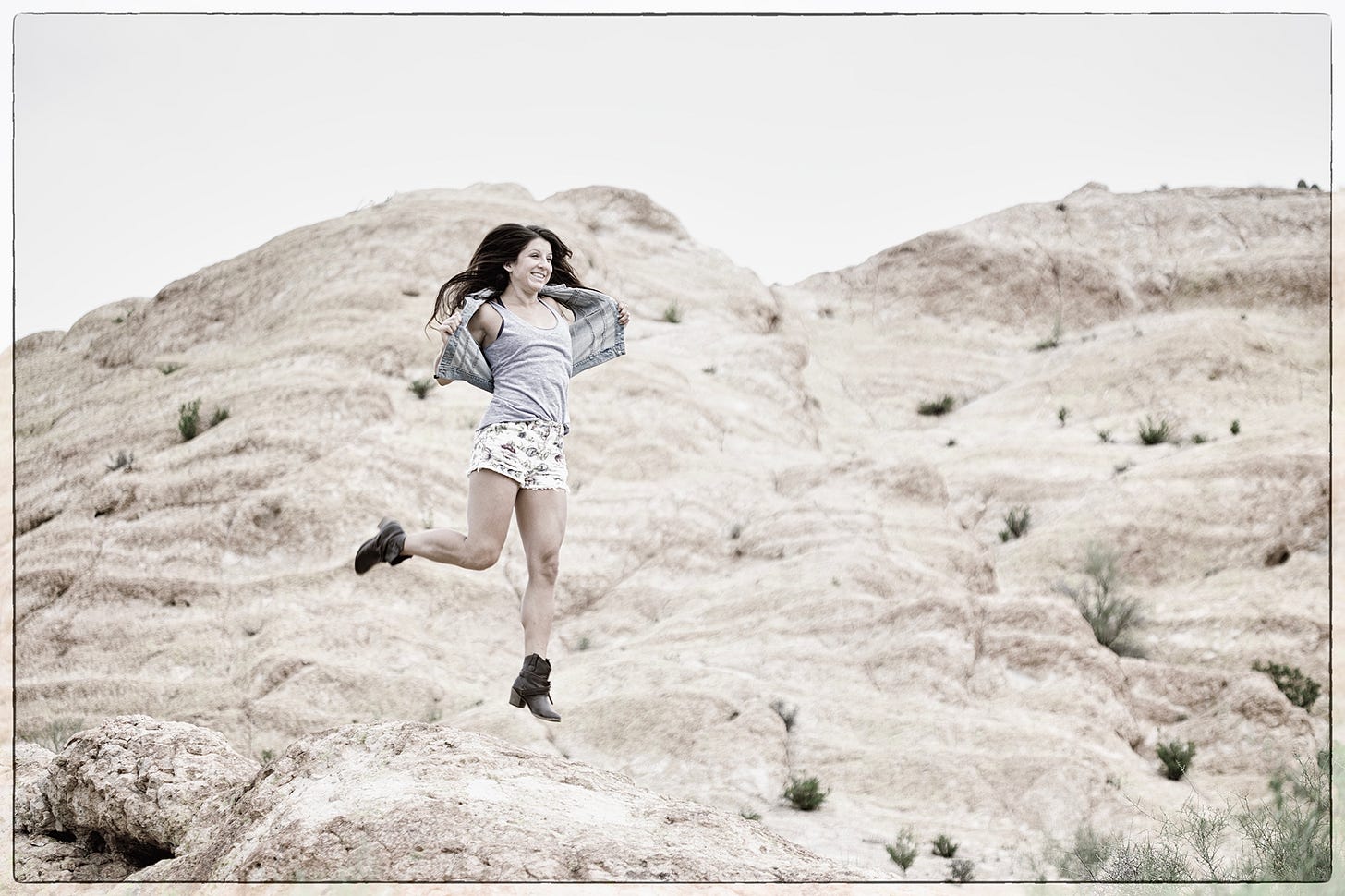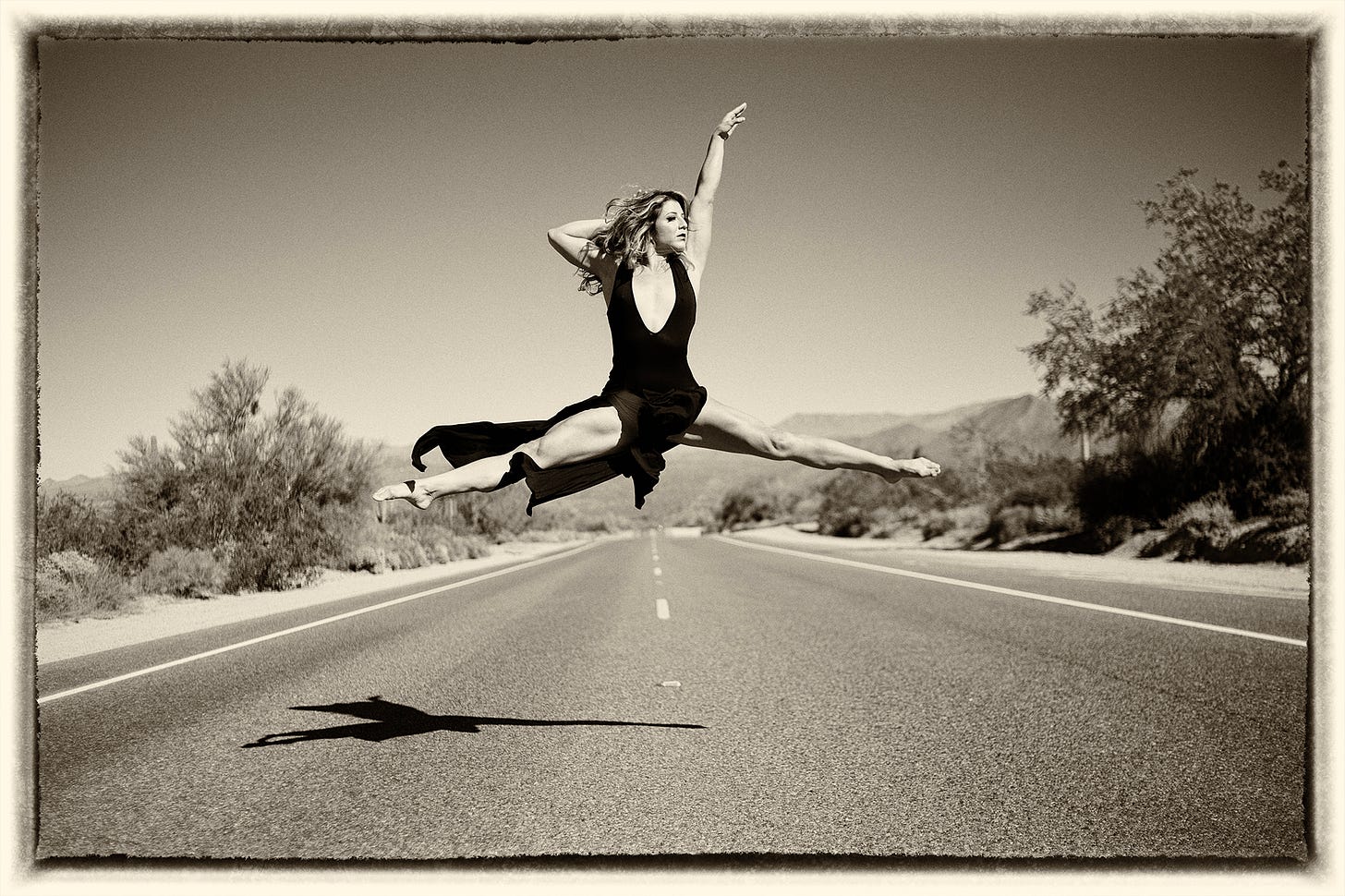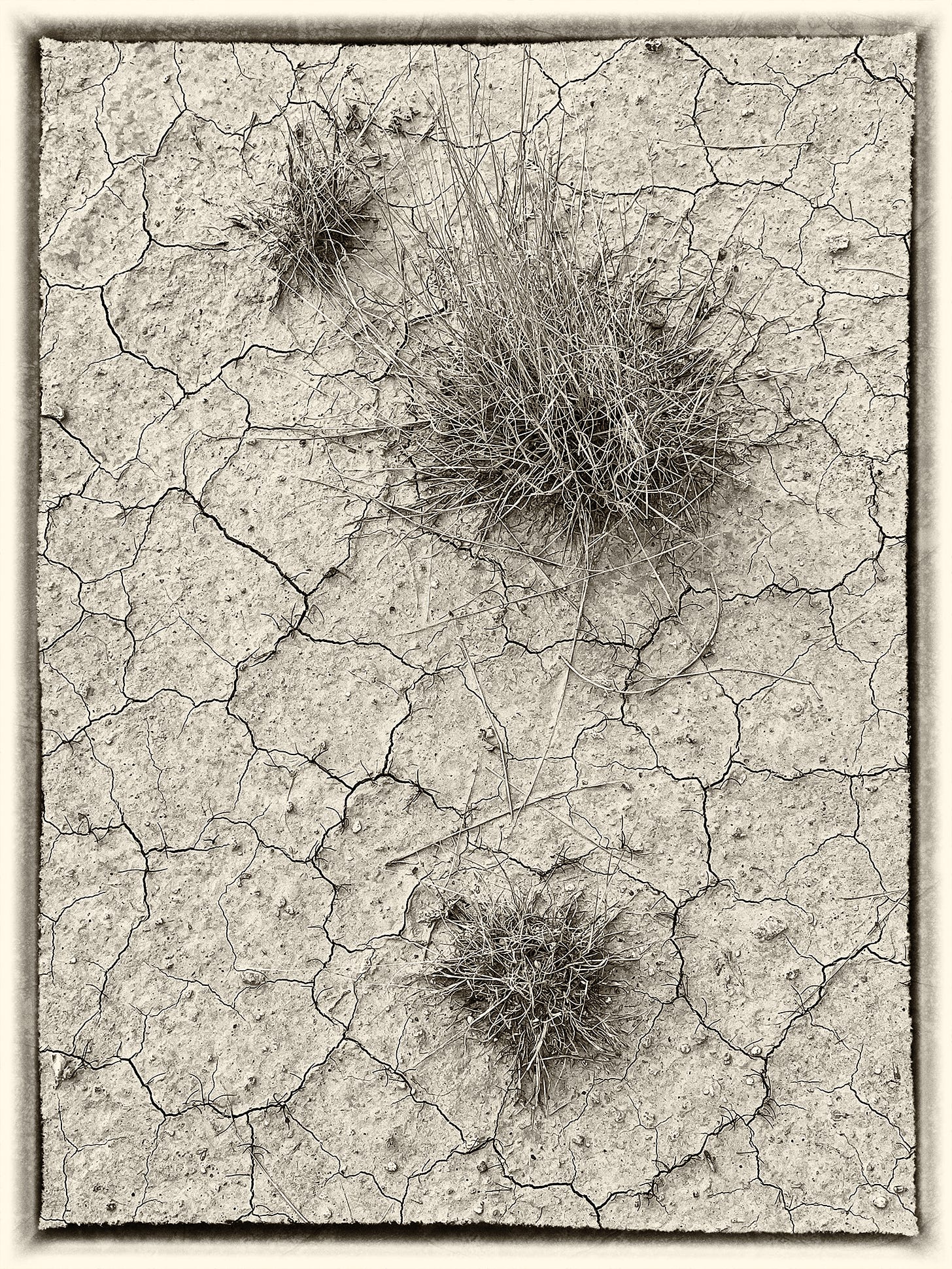Differentiation, Growth, and Becoming Unblocked... With a Twist
A journey of discovery, a week of fear, and why I like being different.
The Challenge of Standing Out Means You are Often the First To Go
When I was working to build my business back in the day, I had no idea what I was supposed to be doing.
I was making photographs for fashion and beauty outlets in the Phoenix, AZ, market thinking I was doing fashion.
I adored photographers like Sarah Moon, Patrick DeMarchelier, and Arthur Elgort.
I had no local role models, no one to learn from, just a growing stack of Italian Vogue, and a hint that there was much more beyond shooting OTR from JC Pennys.
The problem was that everyone in town was doing the same thing. It was hard to tell who had shot the work, let alone get any idea of what they were doing, because they were in the same mix as everyone else.
So I began to shoot differently. Looser. Less ‘posed’ and more dynamic. I had my models moving constantly, not letting the rhythm become the soundtrack of the shoot.
You know the one.
Model moves and stops, photographer shoots, model moves and stops, photographer shoots.
Move, stop, shoot.
Move, stop, shoot.
Move, stop, shoot.
Move, stop, shoot.
Move, stop, shoot.
Who’s in control of the shoot?
The model is telling the photographer “This is what you get, buddy,” and the photographer reacts by rewarding the model with a click.
Not on my set.
Movement became the regime.
There was no rhythm.
No beat of the shutter in perfect time.
My work began to look a lot different. I had explosive body shapes, engaged faces, gravity-defying positions, and a lot more.
I didn’t go into it “looking” for a way to be different. I let my imagination go to where I allowed myself the freedom to try something else.
This new vision gave me access to a few clients that wanted to do something different.
But it also gave the clients who did not want to experiment a ‘wanted poster’ to help them determine that they did NOT want to work with me.
It’s easy to say “Well, they weren’t your clients,” when that happens. But it is no less disappointing. I had to decide to either continue down this new path or give it up and keep the paying customers happy.
I was far too hooked to choose the latter.
I also began wearing only black, became super professional with my paperwork and client outreach, and developed interesting mailers that were not just run-of-the-mill cards.
In other words, I tried to stand out as much as possible, since blending in made even less sense.
What differentiates you from your competition?
Have you given that much thought?
Have you asked yourself “Why would they hire me”?
Could you tell someone why they should choose you to do the work rather than that other guy or gal with the shiny car and super-megapixel-mega-camera?
You should be able to do that, you know.
You should be able to articulate why I should hire you for more money than someone else for less.
If you cannot explain it to a potential client, they may not be able to see it on their own.
When you showcase your uniqueness, no matter how small, you step away from the crowd. The crowd is too noisy to be heard as an individual. Like a violin in the middle of a marching band, you blend in behind the blaring of the trumpets.
And there are always too damn many trumpets.
A simple, unique quality, be it style, wit, charm, point of view, approach to timeless photographs, or simply a body of work that enlightens the viewer and surprises them – even a little bit – can pique clients' interest.
Let’s just say it resonates with them. That’s a good, creative word that means, “Hey, they get it.”
And when they get it, they get you.
That builds trust, and trust builds credibility, and credibility is the currency of commercial art. Establishing yourself as a trustworthy, and fully credible artist, is one of the most important things you can do as a freelance creative.
We call this your brand.
Or at least a big part of it.
Now, I’m not going to go off on the word ‘brand’. It is overused, exploited, and full of a ton of bullshit.
But there is also a deep level of truth in how powerful a brand can be.
It is not your logo, your color palette (I’m a summer – who gives a damn? ), or what typeface you choose for your printed material.
Unless you choose Comic Sans. If you choose Comic Sans, you should immediately seek a warehouse position with Walmart.
I know you can.
But that is not to say your visual identity is unimportant. It absolutely is.
As a visual artist, what you do visually makes a huge statement about your credibility.
How can you say you are a great visual artist if you choose Comic Sans, have a layout that is wonky as hell, and choose colors that make people’s eyes bleed?
Bleeding eyes has never been a good sales tactic.
Your Personal Visual Brand
A consistent visual style across all media is critical for playing the long game in this business.
A good color palette, an appropriate font choice, and a clean and easily recognizable logo are all important.
(That said, your clients are not as interested in that stuff as they are in the imagery. It is far more important to execute and get your work in front of people instead of freaking out about the line spacing of a mailer. Geeeezzz, people. Priorities!)
I suggest getting your visual branding done quickly. Whether it is a good 5-star-rated designer on Fiverr, or a local designer you can do a trade-out with. Tell ‘em what you want, have them execute a good one, and move on. Quickly.
Too many photographers spend too much time on this stuff.
Get it done so we can get to shooting more and showing more.
If you have great images, there ain’t a single client who is going to say “Wow, her work is exceptional. I really wanted to hire her for this cool gig. But I noticed the kerning in her logo was a bit too tight. And that shade of orange is three units of red too much.”
C’mon, man, nobody cares that much.
Personal opinion:
Leave the logo graphic alone. Just pick a great typeface for your logotype and be done with it. A wonderful place to find a good typeface is Creative Market. Spending a few dollars on a logotype will put you in a very small group at the top of brands. Most photographers go to the free fonts at Google.
Executing on the Photography
Now let’s look at some exercises to help you find ways to get to the heart of what you need to know.
Reflect on your strengths: Consider what skills, techniques, and qualities set you apart from other photographers. Are there things you can do to augment your strengths?
Make a list of what you do well.
Make a list of what you do fairly well.
Make a list of what you don’t do well.
Make a list of what you do poorly.
Wow. Helluva list, eh?
We can use this to help us prioritize what to work on, what to focus on, and what we can do to polish up those third and fourth lists.
Now take some time to define your niche. Are you a people photographer, a food photographer, a landscape photographer, or a product photographer? And the subsets within those areas are deep.
Perhaps you have something you do that is unique.
What is it, and how well do you do it?
Now consider your values and what you are, indeed, passionate about.
Do they fit in with your niches? Are you passionate about what you shoot? If so, that is called harmony. If not, that is called dissonance.
We gotta make a great-sounding chord, here, so harmony is what we want to achieve. It is what they see when they see you, your logo, or your work.
They recognize your passion through your work
The visual style and presentation of everything you do emphasize that passion they see.
Your photography is the most logical extension of your brand there is. It IS you.
That means your work must be represented by a supporting cast that uplifts the work, supports the brand, and creates a credible, and powerful solution for your client’s needs.
Your passion, your uniqueness, and your visual statement all contribute to what others think of you. It is what they see when they see you, your logo, or your work.
They recognize your passion through your work
The passion they see is emphasized by the visual style and presentation of everything you do.
Your photography is the most logical extension of your brand there is. It IS you.
That means your work must be represented by a supporting cast that uplifts the work, supports the brand, and creates a credible, and powerful solution for your client’s needs.gh
Getting Over a Block
Oh, no… not that kind of block. Not an artistic block.
I’m talking about a blood clot ‘block’ in my leg.
Again.
After a very tense week of trying to figure out if I indeed had another DVT, it was diagnosed, and I was back on blood thinners.
Super.
I was just taken off of blood thinners for the first time in ten years.
I guess they are back on the menu.
Anyway, the treatment seems to be working its magic and I feel a lot better, although the fatigue and exhaustion that is a hallmark of this malady is letting loose a bit slower than I would like.
I had a DVT ten years ago, and it was nearly existential.
Extinction Level: 9.9.
This one required no hospitalization, although I found it hard to do much of anything, let alone write.
I am doing much better today.
Back at it soon.
Growth and Rebirth
Project 52 is being overhauled and examined like a corpse on a morgue table.
(Too soon?)
I am mixing it into the CreativeClass and I think the blend is going to be amazing.
I have over 200 assignments in Project 52, and I am going to let a lot of them breathe new life into the CreativeClass assignments.
My two upcoming classes will be:
Creating a Marketing Campaign: Soup to Nuts. This is a month-long sprint and will get you everything you need, from an email list to printed drop-offs, to a system for deployment that anyone can follow.
They say it is all about the marketing, this class IS the marketing.
I will also be doing another “Client Acquisition Sprint” for the first week of May. This is a three-day, one-weekend sprint to get you working. It has been super successful for those who have taken it, and this new iteration includes even more.
Well, that’s it for today.
Sorry I was out of pocket, but there was a reason.
See you very soon.
When you are ready, here are three ways I can help you succeed.
Group Mentorship: a small group of photographers who meet to show images, work on their portfolio, and build their businesses with help from a wonderful group. Lifetime membership for one fee.
One-on-one Mentorship: You and me - working together in an intense 6-month push to get you on the way to over $30K in additional revenue. The work we lay down will help you increase and scale your business for years ahead.
The Creative Class: Expand your toolset and become a one-person visual agency capable of pulling in steady and repeated income. If you have questions, let me know, and I will answer them as fast as possible.









